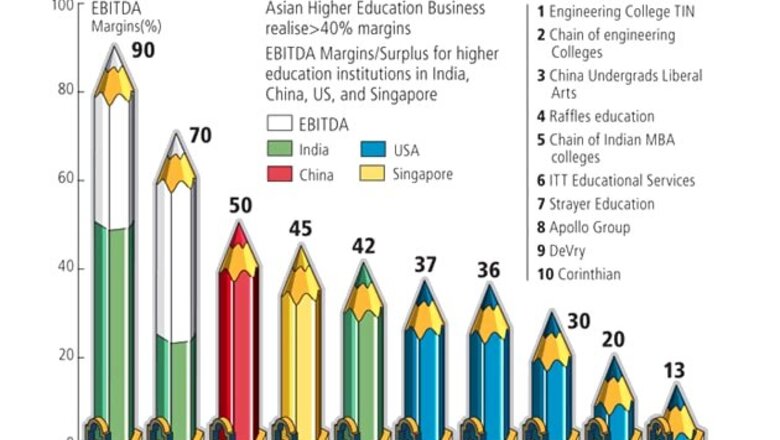
views
There is a story about how Cassius Clay changed his name to Mohammed Ali. There is an equally interesting anecdote about how Jagran Integrated Business School changed its name to Leeds Metropolitan University. Abhishek Mohan Gupta, director (marketing and strategic development) of Jagran Social Welfare Society, which runs Jagran Integrated, wanted to get his alma mater Leeds Met into the country. For five years, he waded through the maze of government approvals. No luck. Leeds remained out. And Gupta remained stuck.
He then used his last trick. He told the government that he wanted to change Jagran Integrated’s affiliation from Barkatullah University to Leeds Met. Nobody had made a request like that before. The absence of precedent befuddled the mandarins who govern higher education and they ended up giving it a go ahead. Overnight, the soul of Leeds Met entered the body of Jagran Integrated. Last year, 70 students were studying there in four programmes. This year, Gupta is ramping this up to 13 programmes. In a few years, Gupta wants to enroll 1,000 students.
That’s not all; Gupta thinks he can use the 36-acre campus even more efficiently. He plans to add two more universities, make student accommodation and food court common to all three and dub the whole thing an "education city”. He has been talking to Nanyang University, Singapore, and New York University for different programmes. He plans to use the same change-of-affiliation route, though things have now gotten easier. Thank you Kapil Sibal, Gupta must surely be saying.
The foreign hand that won’t work
Now that the Cabinet has approved the entry of foreign universities into India, expect education to go the way of the dotcom and the real estate boom that happened in the last decade. Shocking, no? Totally. This in spite of both the minister — Sibal — and the entrepreneur — Gupta — wanting to do the right thing.
If the minister thinks that by allowing foreign universities he can help significantly more Indians to graduate then that’s not going to happen. If Gupta thinks that by rapidly scaling up his campuses he can deliver education of a quality that makes students employable, then that too is bit of a stretch.
Since the bill was approved, all of six universities have shown an inclination to enter India. Virginia Tech, Georgia Tech, Schulich School of Business, Boston University, Middlesex University and Duke University.
But what about the big names: Harvard, Cambridge, Yale, Stanford? Don’t hold your breath. They won’t be coming. Not any time soon. That’s ugly reality #1.
Philip Altbach, director, Center for International Higher Education, Boston College, has been studying the foreign university phenomenon for a while. He says, "With the experience of some other countries, the ones who come in will be low-end, not the Harvards, Stanfords or the Oxfords. They may come in a small way: Just to build their brand or recruit students to come back to the main campus.” These storied institutions have built themselves over hundreds of years. They will not risk cutting down on quality. And add to that the danger of brand dilution. "Our world-class research programmes and our culture of multidisciplinary collaboration, which relies on having a critical mass of expertise in a variety of disciplines, cannot be easily replicated and transplanted elsewhere,” says John Hennessey, president, Stanford University. "We are loath to consider creating a satellite campus that would offer a degree programme that did not live up to the quality that we can offer on our home campus.”
Law of large numbers
Here is ugly reality #2. The number of students that India needs to graduate is so huge that foreign universities just can’t deliver those numbers. "Given the globally observed historical path that developed and more developed countries have gone through in order to increase their GDP levels, India needs to send 22 million people to college in 2014, an increase of 8 million from the 14 million that it currently sends. These students will become high-skilled labour force that will be required in order to support India’s growth trajectory,” says Karan Khemka, partner, The Parthenon Group, an education consulting firm.
Think Parthenon’s numbers are out of whack? Listen to Anand Sudarshan, CEO, Manipal Universal Learning. According to him, the minister has spoken about how he wants to send 30 per cent of India’s college-going-age kids to college. Sudarshan’s estimate is that we need 30 million people going into college and higher education. The National Knowledge Commission set up by the government talks about the need for 1,500 universities — India has 350 now — to meet the human resources challenge.
People have always thought India’s biggest challenge was building ports, roads and power plants. The need to have more college educated kids will be a bigger challenge. In 2008, India had approximately 340 million people in the age group 25-50 year olds who did not have a college degree. According to data from Parthenon, if we don’t speed up adding seats to our college system, this gap will increase to 380 million by 2014. India’s demographic dividend would turn into a deficit instead.
Since foreign universities can’t fill up these numbers, can the government do it? The knowledge commission thinks that at least 50 world class universities can be set over the "medium term”. Here is a reality check. Less than 10 universities have gained global acceptance as world class universities in the last 20-30 years. And it costs at least Rs. 3 lakh per student just to set up a world class university. If each of these 50 universities enrolls 10,000 students, the government would need to put down Rs. 15,000 crore as capital expenditure and the country will only have extra half a million kids in college; way short of the eight million needed.
Coming out of the profit closet
Here is a thought. Drop the pretense and let people make money off the sector. Allow for-profit institutions to work. Let government institutions (and hallowed abbreviations) like IITs, AIIMS or IIM continue to do the fine job that they are doing. Don’t dilute their brand and stretch them with scaling up targets. They should remain islands of excellence. But allow for-profits to exist alongside. Indians trust for-profits for their health by admitting themselves into an Apollo or Wockhardt hospital. They ride with their families in cars made by for-profits like Tata Motors or Maruti. They fly in airlines run by Indigo and Kingfisher. They drive on roads and bridges built by profit-seeking companies. Why is education, higher or otherwise, in the hands of profit-makers such a dangerous idea?
Countries like US and China have used the for-profits to put large numbers of people through college. The for-profits came up in the 1950s-1960s when students went straight to work after high school and thus, needed continuing education. Universities like University of Phoenix, ITT Technical Institute, DeVry University, Capella Education and Laureate Universities International all have a completely market-driven model based on demand. Research suggests that in the US, for-profits educate 7 per cent of the total enrollments in degree-granting institutions each year. University of Phoenix has about 455,000 students today. Both Phoenix and Devry were profitable right through the economic meltdown!
But in India, if you turn into a for-profit, then you can’t award degree or diplomas. Consider the case of Mumbai Business School. The folks there wanted an independent programme because they wanted to deliver high quality programmes that were contemporary and relevant. The University Grants Commission (UGC) and the All India Council for Technical Education (AICTE) are too sluggish to update and modernise their guidelines, says Sunil Rai, CEO, Mumbai Business School. "For instance, take UGC guidelines for the MCA programme. It still mandates that students be taught Pascal and Fortran that are now outdated. They don’t include things like ERP [enterprise resource planning] that are current,” he says.
Mumbai Business School is structured as a company and not a trust that manages an educational institute. What it gains in profit it loses in recognition. "Only a university under UGC or a college under AICTE can award degrees and diplomas. And we don’t offer that but there is always the danger that AICTE can put us in the list of non-recognised institutes on their Web site,” says Rai.
Since profit is not allowed, people who can grease the system are setting up educational institutes. There are sweet-meat sellers who are purveyors of higher education now. India’s higher education regulations are so stifling that, for the most part, it has only discouraged serious players from getting in. The result: The bulk of the private players in higher education are those who want to make a fast buck. Already, everyone connected to an educational institute makes money using the management company model. Just let it be above board.
The for-profit motive will also allow capital to move in to create different models for different needs. Most students that will form the extra eight million will need decent quality education and at prices that can be recovered within four years after graduation. That might sound heretic in a country where most kids aspire to end up in an IIT or a Regional College of Engineering, All India Institute of Medical Sciences, St. Stephens or a National Law School. The reality is that only two per cent of aspirants will end up in those hallowed portals. The rest will have to go to a good college, not great, just good. The world over, and even in India if you include some decent private engineering colleges, such colleges have a good reputation and also make money for their investors.
Since very few countries have had to address a challenge that combines such large numbers and quality as India, the government will have to look at higher education approaches taken by many countries rather than just one. But the models in three countries hold a lot of promise: China, Singapore and Malaysia.
The experience elsewhere
Several countries have experimented with foreign universities. Israel lifted the barriers on foreign universities 15 years ago. The country did not have enough capacity for its own students and also didn’t want them to go abroad for higher studies. Education providers from the US, UK and Romania rushed into Israel and set up branch campuses but the quality wasn’t up to the mark. Ultimately, the government realised that the whole sector had become a mess and imposed serious regulations. All the fly-by-night operators exited immediately.
But not every experiment is like Israel’s. Over the years, Singapore and then Dubai tried to create regional educational hubs by attracting top-flight foreign universities to set up campus. Singapore’s model was highly regulated and no one was allowed to enter the country unless the Economic Development Board (EDB) of Singapore invited them and scrutinised them under a series of very strict measures. The Singapore government would then dish out generous grants for research or infrastructure, and also keep tabs on progress. Sure enough, the likes of INSEAD, University of Chicago’s Booth School of Business and Cornell rushed to Singapore. While some like INSEAD have done very well, there have been spectacular failures too. Like the University of New South Wales that was setting up a 22 hectare, $200-million campus with a capacity of 15,000 students in Singapore. This would have been the biggest offshore campus that the world had ever seen. It wound up its Singapore plans even before the construction was complete. The reasons: Lack of demand to make the whole project viable. Later on, the Singapore government asked John Hopkins University to shut shop because of quality issues. In comparison, Dubai and Qatar haven’t been quite as successful as Singapore mostly because their regulation isn’t tight enough. So for every London Business School or Carnegie Mellon, there are tonnes of B and C rung foreign universities that have established a presence in Dubai.
Truly Asia
Experts reckon that Malaysia is another country to watch. Malaysia’s situation is somewhat like India: Unlike a Singapore or a Dubai that aspired to become regional education hubs, Malaysia initially allowed foreign universities more to serve the local population. It was only recently that it decided to
focus on becoming a regional educational hub. To make this happen, it set up transparent mechanisms and a regulatory authority called the Malaysian Quality Authority. Malaysia allows for-profit institutions as well. In addition they have a well-structured guaranteed student loan and scholarships regime. This makes sure that the individual Malaysian is supported. "One of the key part of education reform is making sure that the individual is supported — help them make choices and be able to pay for those choices,” says Sudarshan of Manipal Universal Learning. Manipal, incidentally, was the first foreign entity that was allowed to set up a medical college in Malaysia. Malaysia’s efforts at trying to become a regional hub have started to pay off: Five years back, the total number of non-Malaysians studying there was less than 30,000. This year, it is expected to cross 100,000 and will probably end up crossing 85,000.
Dragon gets into the act
China is facing a strange problem: A problem of plenty. Kathryn Mohrman, professor of practice, School of Public Affairs, Arizona State University, and an observer of China’s higher education system, says, "Because the expansion of the higher education system has been so rapid, there are just not enough suitable jobs for those who graduate.” While that is a problem, considering the fact that China began from a base that was way lower than India’s, what China has achieved in a short span is impressive. Ten years ago, about 50 per cent of students who completed 12 years of education, got into universities. Today, China sends 80 per cent of 12-pass students to college — three times what India sends.
While Mohrman thinks that China’s attempts at setting things right in the higher education space have only met with mixed success, there sure are things that China has done right. And there might be some lessons there for India.
Take foreign universities themselves. During Deng Xiaoping’s reign some 30 years ago, China decided to allow foreign universities in. China discovered that some of the more aggressive foreign universities were the for-profits. In fact, they were more interested in making money and paid less attention to students. "In the last few years, they restricted new foreign universities because quality was low, students were paying a lot of money but not getting suitable job skills,” says Mohrman. China has stipulated that foreign universities need to have a Chinese partner.
The Chinese model can be understood in the context of its leading private university Yellow River University of Science and Technology. It started diploma courses in 1994 and degree in 1999. By 2007, it had 13,000 students in 37 degree programmes. And then it collaborated with two top government universities, Tongji in Shanghai and Huazhong University of Science and Technology in Wuhan, to run a number of master’s degree programmes. The advantages of this approach are many. "The private university gets the knowledge and expertise to run higher level masters programme from government institutions. The government institute gets 25 per cent of the profits that private university makes and which it uses to fund its research,” says Khemka of Parthenon.
China has also brought in a degree of accountability into the system. So if a university wants to increase the number of seats in, say information technology, it needs government permission. After that, the government tightly monitors the progress of students from that programme. Only if they get good jobs, is the university allowed to maintain or increase seats in IT.
Answers lie within
So can India mix and match Singapore’s approach to quality, China’s path to scale and Malaysia’s ambition of becoming a regional education hub? That’s some way off, but it is possible to see some early experiments within the existing constraints.
About 155 kilometres from Delhi in the Aravalli range is the fort town of Neemrana. Last year, this little town saw a 100-acre university campus come up. Built at a cost of Rs. 100 crore (to go up to Rs. 1,000 crore over 10 years), NIIT University is the brainchild of Rajendra S. Pawar, one of India’s foremost education entrepreneurs. By the time it is complete, it will have a capacity of 5,000 students. What Pawar is doing with NIIT University, in many ways, challenges our conventional notion of higher education: Be it about curriculum design, pedagogy, the emphasis on cross-disciplinary learning, industry linkages and even student selection. While it is too early to label NIIT University a success, it is an example of what can be achieved by allowing private enterprise into this area.
Being established as a not-for-profit trust has its own complications. One, you have little freedom in fixing the fees. (you can indeed fix the fees if you are a deemed university or a private state university, but it is very tough to get that status from the government). In India, student fee is the key source of income for an educational institution. What makes matters worse is that there is a cap on class sizes as well so these institutions can’t raise their intake, and hence improve fee income.
At the same time, things like faculty compensation are going up and hence operating costs are rising. "For an institution to grow, capital expenditure has to be regularly incurred. For a not-for-profit, the only recourse is debt, which has to be serviced. The debt servicing cost and the principal pay-back requirements, further add to the outflow side,” says Manipal’s Sudarshan. "Except for institutions which have been around for decades, it’s quite difficult for any institution to have annual surpluses consistently.”
Things that should change
So what needs to change? "We need to liberalise education,” says Pawar. By liberalisation, he means that entry and exit into education has to be much easier: One should be able to start and close an institution in a much easier way (of course, in a measured, regulated manner). Similarly, individual institutions should have the freedom of what to teach and how to teach, and how to fix the fees and manage costs.
To get private players interested in education, a lot of the existing regulations need to change. One, it shouldn’t be binding on an educational institute to set up as a not-for-profit trust. They should also be allowed to set up as corporations, with the flexibility to use their profits as they wish to. "A public company is a lot more accountable to the many constituencies it serves as against a trust. Whatever is the regime there should be accountability,” says Sudarshan. The argument against for-profits is that it may allow inferior quality institutions who are in just to make money. But to prevent that from happening, the government can build some safeguards such as not allowing private institutions to give dividends for, say, the first 10 years of their existence.
The other big revamp needed is in the accrediting infrastructure. We have regulators that don’t have teeth. Sibal has been proposing a National Accreditation Regulatory Authority. This body will fix the accreditation norms and outsource the actual accreditation to outside agencies in a tightly-monitored process. Every institute will have to go through mandatory accreditation. Another one of Sibal’s proposals talks of establishing a National Education Finance Corporation that would disburse loans to government, aided and private educational institutions.
Investors, on their part, are still viewing the changes in India’s higher education sector with caution and no one is willing to take the plunge immediately. Says Manipal’s Sudarshan, "People from overseas will come in only if capital is fungible. If I bring in capital and there is absolutely no way for me to take the capital back for whatever reason, why would I want to put in the capital in the first place?”
Good question. We all know the answer. Only if they could put it down as a policy now.
The China model
When: In 1999.
What: China decided to get more people into college.
Trigger: Tension from the limited capacity of the higher education system. In 1998, about half of all junior school students went to senior high school. And only a tenth of these students attended a college.
Solution: Prestigious government universities have set up second-tier colleges that boost enrolment and generate income. Independent private universities like Yellow River and Minsheng collaborate with top government universities like Tongji in Shanghai and Huazhong University of Science and Technology in Wuhan, to run a small number of master’s degree programmes.
Result: Private universities have come to account for about 6.6 per cent of student enrollments, or about 1.34 million of the 20.2 million students enrolled in formal higher education in 2006.



















Comments
0 comment